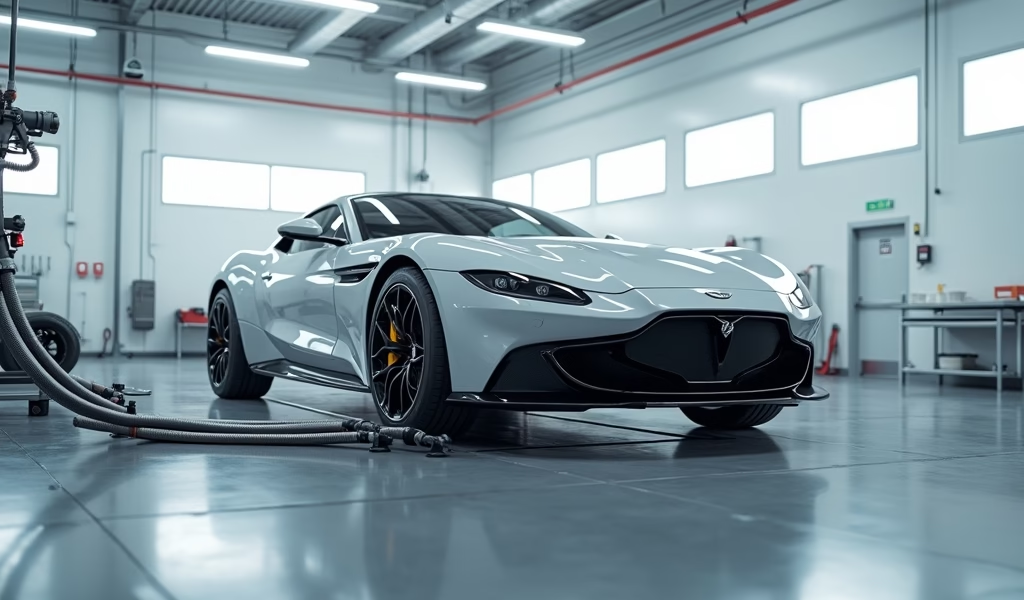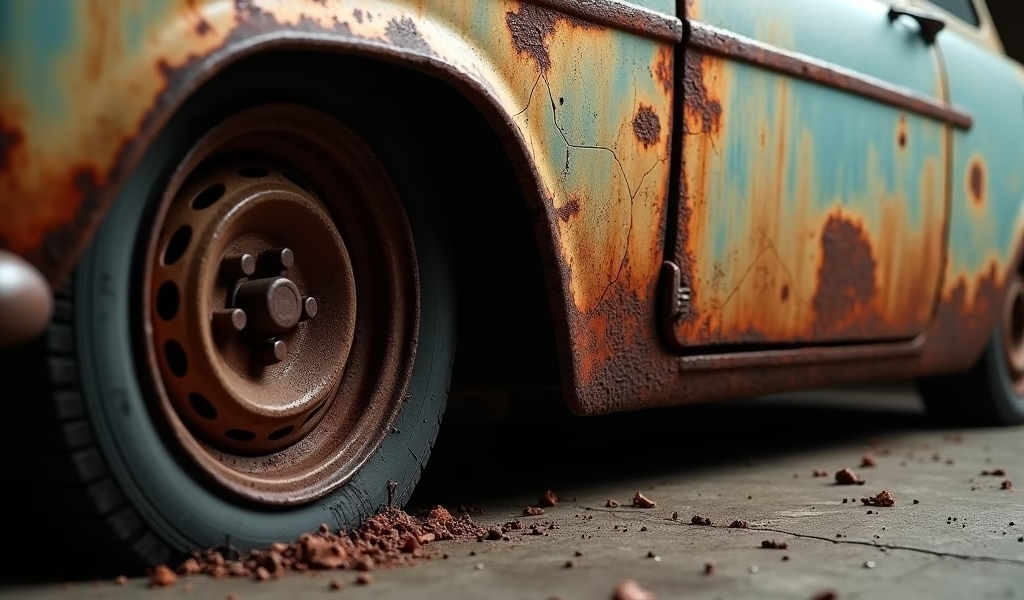Overview
This article outlines five professional techniques to prevent vehicle rust: regular washing, applying protective coatings, undercoating, immediately addressing paint damage, and proper storage. These preventative measures can save thousands in repair costs, preserve up to 30% of a vehicle’s resale value, and extend its useful life by 3-5 years.
Table of Contents
- Understanding Vehicle Rust: The Enemy of Every Car Owner
- Pro Tip #1: Regular Washing and Detailing – Your First Line of Defense
- Pro Tip #2: Apply Protective Coatings – Creating a Moisture Barrier
- Pro Tip #3: Undercoating and Cavity Protection – Protecting the Hidden Areas
- Pro Tip #4: Address Paint Damage Immediately – Stop Rust Before It Starts
- Pro Tip #5: Proper Storage and Environmental Protection – Give Your Car a Safe Home
- Conclusion: Your Action Plan for a Rust-Free Vehicle
- Frequently Asked Questions
Understanding Vehicle Rust: The Enemy of Every Car Owner
I’ve been working on cars for over 25 years, and if there’s one thing I’ve learned, it’s that rust is a vehicle’s worst enemy. By car standards, rust is like a silent cancer – it starts small, often unnoticed, then aggressively spreads until your ride is compromised both structurally and visually.
What’s particularly concerning is how quickly rust damage adds up financially. Recent industry data shows rust can decrease your vehicle’s value by up to 30% and cut its useful life by 3-5 years. When you consider that serious rust repair can cost anywhere from $500 for minor fixes to over $3,000 for extensive damage, prevention becomes a no-brainer for your wallet.
Rust forms when the metal components of your vehicle (primarily iron-based) react with oxygen and moisture. This chemical process creates iron oxide – what we commonly call rust. The process accelerates dramatically when salt enters the equation, which explains why vehicles in coastal areas or regions using road salt in winter suffer more severe and rapid corrosion.
The most vulnerable areas include your wheel wells, rocker panels, exhaust system, and undercarriage. These spots take the brunt of water spray, salt exposure, and flying road debris – creating perfect conditions for corrosion to take hold.
As a mechanic who’s had to deliver the bad news to countless car owners, I can tell you that prevention is exponentially more cost-effective than repair. Once rust takes hold, especially when it’s eaten through metal, there’s no easy fix. Often the only solution is cutting out affected areas and welding in new panels – a labor-intensive and expensive process that no one looks forward to.
Let’s explore five professional-grade strategies I recommend to my own customers to keep rust at bay and save thousands in potential repair costs. These tips are drawn from decades in the garage bay and will help extend your vehicle’s life regardless of where you live.

Pro Tip #1: Regular Washing and Detailing – Your First Line of Defense
The simplest rust prevention method is often the most overlooked: regular washing. Think of it like brushing your teeth – a routine that prevents bigger problems down the road.
During winter months when roads are treated with salt, I tell my clients to wash their vehicles every 7-10 days. This might seem excessive, but salt is incredibly corrosive and starts damaging your car’s metal components almost immediately. In milder climates, monthly washing should be your minimum standard.
What many drivers miss is the undercarriage – out of sight shouldn’t mean out of mind. This area collects the most salt, mud, and debris, making it particularly vulnerable to corrosion. Most automatic car washes offer undercarriage spray options, but they’re often brief and may miss crucial areas.
For true protection, I recommend getting a specialized undercarriage wash quarterly. If you’re a DIY enthusiast, invest in a garden sprinkler attachment that you can slide under your vehicle to rinse the underside thoroughly. Pay special attention to wheel wells and the areas behind your bumpers where mud and debris collect.
When washing, use proper automotive soap rather than household detergents, which can strip protective waxes and sealants. Finish with a thorough drying – standing water is an invitation for corrosion to begin, especially in seams and crevices.
After decades in the shop, I’ve seen firsthand how vehicles maintained with regular washing hold up dramatically better against rust than neglected ones. This simple habit can add years to your car’s life and preserve thousands in resale value – all for the cost of some soap and water.
Pro Tip #2: Apply Protective Coatings – Creating a Moisture Barrier
Protective coatings create a barrier between your car’s paint and the elements. They’re like sunscreen for your vehicle – an extra layer of defense against damaging exposure.
In my garage, we recommend different coating options based on your budget and protection needs:
- Car wax: The most affordable option, providing 2-3 months of protection. Great for seasonal application and DIY enthusiasts.
- Synthetic sealants: More durable than traditional waxes, offering 6-8 months of protection and excellent water repellency.
- Ceramic coatings: The gold standard in protection, lasting 1-5 years with superior hardness and chemical resistance. These typically require professional application.
For most daily drivers, I recommend waxing quarterly or applying a quality synthetic sealant twice a year. The process is straightforward enough for weekend warriors to handle, and the results are immediately visible in how water beads on the surface.
Ceramic coatings represent a bigger initial investment (typically $500-1,500 for professional application), but their long-term protection makes them cost-effective when amortized over their lifespan. According to Consumer Reports’ vehicle protection studies, proper coatings can significantly extend the life of your vehicle’s exterior.
Remember that protective coatings aren’t just about keeping your car looking showroom-fresh. They create a hydrophobic (water-repelling) surface that prevents moisture from settling on your paint and finding its way to the metal beneath. This is critical rust prevention that pays dividends in preserved value and avoided repair costs.
As a mechanic who’s seen thousands of vehicles in various states of preservation, I can tell you that consistent application of quality protective coatings is one of the clearest dividing lines between well-maintained vehicles and those suffering premature corrosion.
Pro Tip #3: Undercoating and Cavity Protection – Protecting the Hidden Areas
The most critical rust prevention happens where you can’t see it. Your vehicle’s undercarriage and internal cavities are prime targets for corrosion because they trap moisture and road salt while remaining out of sight.
Modern undercoating options fall into three main categories:
- Rubberized undercoating: Creates a thick protective layer that also dampens road noise. Excellent physical protection but needs inspection for chips or cracks annually.
- Oil-based treatments: These penetrate seams and hard-to-reach areas, providing excellent rust prevention in crevices. They require annual reapplication.
- Wax-based products: Offer a compromise between the previous options with good adhesion without trapping moisture against metal surfaces.
In my 25+ years turning wrenches, I’ve seen the best results from a two-pronged approach: a quality rubberized coating for exposed undercarriage components combined with oil-based cavity protection for internal frame rails, rocker panels, and door bottoms.
The ideal time for initial undercoating is when your vehicle is new, but it’s never too late to start. I’ve applied undercoating to 10-year-old vehicles that significantly slowed further corrosion and extended their useful life.
Focus your protection efforts on frame rails, floor pans, and wheel wells – areas most vulnerable to salt and moisture exposure. Many quality shops offer pressure-washing preparation before application to ensure you’re not sealing in existing contaminants.
If budget is a concern, some undercoating products are DIY-friendly, though professional application typically provides more thorough coverage. For car buyers considering a new purchase, dealer-applied undercoating can be negotiated into your sale price and is often worth the investment, especially in northern climates.
My professional recommendation is to budget for undercarriage inspection and maintenance annually. This preventative approach costs far less than cutting out and replacing rusted structural components down the road. Your undercarriage may be out of sight, but it should never be out of mind in your maintenance routine.

Pro Tip #4: Address Paint Damage Immediately – Stop Rust Before It Starts
In my decades as a mechanic, I’ve seen how quickly a tiny rock chip can become a rust spot, then a rust hole. Paint isn’t just about looks – it’s your car’s primary defense system.
When your vehicle’s paint is compromised, even by a pinhead-sized chip, moisture gains direct access to the metal beneath. Once this happens, the corrosion process begins immediately. What could have been fixed with a $10 touch-up pen becomes a $500+ body shop repair if neglected.
Here’s my straightforward approach to addressing paint damage:
- For chips smaller than a pencil eraser: Clean the area thoroughly, apply a rust inhibitor if you see bare metal, then use a factory-matched touch-up paint. Finish with a clear coat pen for seamless protection.
- For larger scratches or areas already showing rust: These require more attention. Start by gently sanding the rust away, apply a rust converter product, then primer before touch-up paint.
- For significant damage or perforation: This requires professional attention. Don’t delay – rust spreads surprisingly quickly once it breaches your paint.
Touch-up paint products matched to your vehicle’s color code (found on the driver’s door jamb sticker) are readily available at auto parts stores and dealerships. These modern formulations are vastly improved over older products and can create nearly invisible repairs when properly applied.
I recommend doing a paint inspection monthly, especially after driving on gravel roads or through construction zones. Pay particular attention to your hood, front bumper, and lower door edges – areas most likely to suffer stone chips and road debris damage.
For first-time car buyers especially, developing this inspection habit can save thousands in future repairs. The fifteen minutes spent looking over your paint occasionally might prevent a $2,000 repair bill down the road.
Remember that modern clear coats can hide damage to the colored base coat beneath. Run your fingertips over suspicious areas – you’ll often feel chips or scratches before they’re easily visible. This tactile inspection has saved many of my customers from developing serious rust issues.
Pro Tip #5: Proper Storage and Environmental Protection – Give Your Car a Safe Home
Where and how you store your vehicle plays a surprisingly large role in its susceptibility to rust. The ideal environment provides protection from precipitation, temperature fluctuations, and high humidity – all factors that accelerate corrosion.
Garage storage is the gold standard for rust prevention. It shields your vehicle from rain, snow, UV damage, and temperature extremes. A climate-controlled garage is even better, maintaining stable humidity levels that discourage condensation on metal surfaces.
If garage storage isn’t available, consider these alternatives:
- Carports: Provide protection from direct precipitation and some UV exposure
- Quality car covers: Look for water-resistant, breathable materials with soft inner linings
- Portable garages: Temporary structures that offer significant protection at moderate cost
In high-humidity environments, even garage storage can present problems. According to Hagerty’s vehicle preservation experts, the ideal storage humidity is between 40-50%. Above this range, condensation becomes increasingly likely, especially during temperature fluctuations.
For my clients in humid regions, I recommend using a dehumidifier in their garage or storage area. The modest electricity cost is far outweighed by the corrosion protection provided. Desiccant packages or moisture absorbers can also help in smaller spaces.
During winter months, avoid parking over snowbanks whenever possible. The melting snow creates a high-humidity environment directly under your vehicle – precisely where you don’t want additional moisture.
For vehicles stored long-term (3+ months), consider these additional steps:
- Apply a quality wax or sealant before storage
- Maintain tire pressure to prevent flat spots
- Use a battery tender to maintain charge
- Place moisture absorbers inside the cabin
Proper storage might seem like a passive approach, but it’s actually one of the most effective rust prevention strategies available. The cars I see with the least corrosion invariably belong to owners who provide good shelter for their vehicles – regardless of the vehicle’s age or value.
Conclusion: Your Action Plan for a Rust-Free Vehicle
After decades in the shop, I’ve seen firsthand how these five rust prevention strategies can dramatically extend a vehicle’s life. The cars that roll into my bay with minimal rust at 10+ years old aren’t magical – they simply belong to owners who implemented these protective measures consistently.
Let’s break down the financial reality: investing $200-600 annually in these preventative measures can save you thousands in repair costs while preserving up to 30% of your vehicle’s resale value. The math isn’t complicated – prevention is dramatically more cost-effective than repair.
Start with regular washing and work your way through the more intensive protective measures as your budget allows. Even implementing just the first two strategies will put your vehicle ahead of most on the road today.
Remember that rust prevention isn’t a one-and-done effort – it’s an ongoing commitment to your vehicle’s longevity. Seasonal maintenance should become part of your routine, with special attention before and after winter in salt-belt regions.
For those who’ve inherited vehicles with existing rust issues, don’t despair. Starting these preventative measures can significantly slow further deterioration, even if you can’t reverse damage already done.
Your vehicle is likely one of your largest investments. These five strategies represent the most effective ways to protect that investment from rust’s relentless assault. The time and money you spend on prevention today will pay dividends for years to come in the form of a safer, more valuable, and longer-lasting vehicle.
Frequently Asked Questions
How often should I wash my car to prevent rust?
Wash your car every 7-10 days during winter months when roads are salted, and at least monthly during the rest of the year. Pay special attention to the undercarriage, which collects the most salt and debris.
Is undercoating worth the cost?
Yes, undercoating is one of the most cost-effective rust prevention measures, especially in areas that use road salt. A proper undercoating application typically costs $100-500 but can prevent thousands in rust repair.
Can I remove rust myself or should I see a professional?
Small surface rust spots can be addressed DIY with sandpaper, rust converter, primer and paint. For rust that has perforated metal or affects structural components, professional repair is necessary.
What’s the best way to protect a new car from rust?
Start with dealer-applied undercoating, then maintain regular washing, seasonal waxing, and immediate touch-up of any paint chips. These habits established early will significantly extend your vehicle’s rust-free life.
Does where I live affect how quickly my car will rust?
Absolutely. Coastal areas (salt air), regions using road salt in winter, and high-humidity environments accelerate rust formation significantly. Vehicles in these areas require more frequent protective measures.


Pingback: edm car: Proven 7-Step Maintenance Tips - knowsyourcar.com